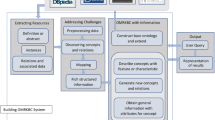Abstract
The emergence of semantic web will result in an enormous amount of knowledge base resources on the web. In this paper, a generic Knowledge Base Grid Architecture (KB-Grid) for building large-scale knowledge systems on the semantic web is presented. KB-Grid suggests a paradigm that emphasizes how to organize, discover, utilize, and manage web knowledge base resources. Four principal components are under development: a semantic browser for retrieving and browsing semantically enriched information, a knowledge server acting as the web container for knowledge, an ontology server for managing web ontologies, and a knowledge base directory server acting as the registry and catalog of KBs. Also a referential model of knowledge service and the mechanisms required for semantic communication within KB-Grid are defined. To verify the design rationale underlying the KB-Grid, an implementation of Traditional Chinese Medicine (TCM) is described.
Similar content being viewed by others
References
Patil R S, Fikes R E, Patel-Schneider P Fet al. The DARPA: Knowledge sharing effort: Progress Report. KR'92, Principles of Knowledge Representation and Reasoning:Proc. the 3rd Int. Conf., San Mateo, California: Morgan Kaufmann, 1992, pp. 777–788.
FIPA' ACL: The Foundation for Intelligent Physical Agents (FIPA), Agent Communication Language. http://www.fipa.org/repository/aclspecs.html.
Cohen Paul R, Robert Schrag, Eric Joneset al The DARPA high performance knowledge bases project.Artificial Intelligence Magazine, 1998, 19(4): 25–49
Vinay K Chaudhri, Adam Farquhar, Richard Fikeset al. OKBC: A programmatic foundation for knowledge base interoperability. InProc. AAAI'98 Conf., Madison, WI, 1998, pp. 600–607.
Tim Berners-Lee, James Hendler, Ora Lassila. The Semantic Web.Scientific American, May 2001.
Ian Foster, Carl Kesselman, Steven Tuecke. The anatomy of the grid: Enabling scalable virtual organizations.Lecture Notes in Computer Science, 2001, 2150: 1–26.
Foster I, Kesselman C, Nick J M, Tuecke S. The Physiology of the Grid: An Open Grid Services Architecture for Distributed Systems Integration. 2002, http://www.globus.org/ogsa/.
RDF Model Theory. http://www.w3.org/TR/rdf-mt/.
Deborab L McGuiness, Richard Fikes, James Hendler, LynnAndrea Stem. DAML+OIL: An ontology language for the semantic Web.IEEE Intelligent System, Sep.–Oct. 2002, pp. 72–80.
W3C Web-Ontology (WebOnt) Working Group. http://www.w3.org/2001/sw/WebOnt/.
Robert MacGregor, Raymond Bates. The loom knowledge representation language. InProc. the Knowledge-Based Systems Workshop, St. Louis, MO, 1987, pp. 21–23.
Ronald J Brachman, Deborah L McGuinness, Peter F Patel-Schneideret al. Living with CLASSIC: When and How to Use a KL-ONE-Like Language. John Sowa (ed.), Principles of Semantic Networks: Explorations in the representation of knowledge, San Mateo, California: Morgan-Kaufmann, 1991, pp. 401–456.
Harold Boley, Said Tabet, Gerd Wagner. Design rationale of RuleML: A markup language for semantic web rules. InProc. Int. Semantic Web Working Symposium (SWWS), Stanford, 2001, pp. 381–402.
Conor Hayes, Padraig Cunningham. Shaping a CBR view with XML.Lecture Notes in Computer Science, 1999, 1650: 468–482.
Chen Huajun, Wu Zhaohui. CaseML: A RDF-based case markup language for case-based reasoning in semantic web. InProc. the 5th Int. Conf. Case-based Reasoning, ICCBR 2003, Norwegian University of Science and Technology (NTNU) in Trondheim.
Jeen Broekstra, Arjohn Kampman, Frank van Harmelen. Sesame: A generic architecture for storing and querying RDF and RDF schema.Lecture Notes in Computer Science, 2002, 2342: 54–68.
DARPA DAML Query Language. http://www.daml.org/2002/08/dql/.
Karl Czajkowski, Steven Fitzgeral, Ian Fosteret al. Grid information services for distributed resource sharing. InProc. the 10th IEEE Int. Symp. High-Performance Distributed Computing, IEEE Press, 2001, pp. 75–89.
Tim Finin, Yannis Labrou, James Mayfield. KQML as an agent communication language. InProc. the 3rd Int. Conf. Information and Knowledge Management (CIKM'94), Gaithersburg, MD, USA, ACM Press, 1994, pp. 456–463.
Chen Huajun, Wu Zhaohui, Xu Jiefeng. TCM-Grid: Weaving a medical grid for traditional Chinese medicine. InProc. Workshop on Innovative Solutions for Grid Computing in Int. Conf. Computational Science (ICCS2003), Melbourne, Australia, 2003.
Jiefeng Xu, Huajun Chen, Zhaohui Wu. A generic knowledge base grid for traditional Chinese medicine. InProc. Int. Workshop on Grid and Cooperative Computing of Chinese Academic of Science, Beijing: Publishing House of Electronics Industry, 2002, pp. 1158–1165.
Noy N F, Sintek M, Decker S et al. Creating semantic web contents with protege-2000.IEEE Intelligent Systems, 2001, 16(2): 60–71.
Cannataro M, Talia D. KNOWLEDGE GRID: An anchitecture for distributed knowledge discovery.Communications of the ACM, 2003, 46: 89–93.
Sheila A Mcllraith, Tran Cao Son, Honglei Zeng. Semantic Web service.IEEE Intelligent Systems, 2001, 16(2): 46–53.
The DAML Services Coalition. DAML-S: Web Service Description for the Semantic Web.Lecture Notes in Computer Science, 2002, 2342: 348–363.
Global Grid Forum, Semantic Grid Research Group. http://www.semanticgrid.org/GGF/
Author information
Authors and Affiliations
Corresponding author
Additional information
This work is supported in part by the Foundational Technology and Research Program, China Ministry of Science and Technology, and the National Hi-Tech R&D 863 Program of China under Grant No.2001 AA414320, and the National Hi-Tech R&D 863 Program of China under Grant No. 2001AA113142.
WU ZhaoHui received the Diploma in computer science from Zhejiang University in 1988 and is a member of Sino-Germany jointly train Ph.D. program from 1991 to 1993. He is currently a professor in the College of Computer Science of Zhejiang University and the deputy director of the Research Institute of System Engineering of Computer, Zhejiang University. He is a member of the Committee of Experts of the National Hi-Tech R&D Program of China. His research interests cover the range of distributed artificial intelligence, grid computing, biometrics, embedded system etc. He has published about 100 papers in high-level international conferences and journals.
CHEN HuaJun received a Diploma from Zhejiang University in 2000. Now he is a Ph.D. candidate majoring in computer science in Zhejiang University. His research interests include semantic web, grid computing, and description logic.
XU JieFeng received a Diploma in computer science from Zhejiang University in 2001. His research interests include semantic web, grid computing and Petri net.
Rights and permissions
About this article
Cite this article
Wu, Z., Chen, H. & Xu, J. Knowledge base grid: A generic grid architecture for semantic web. J. Comput. Sci. & Technol. 18, 462–473 (2003). https://doi.org/10.1007/BF02948920
Received:
Revised:
Issue Date:
DOI: https://doi.org/10.1007/BF02948920




